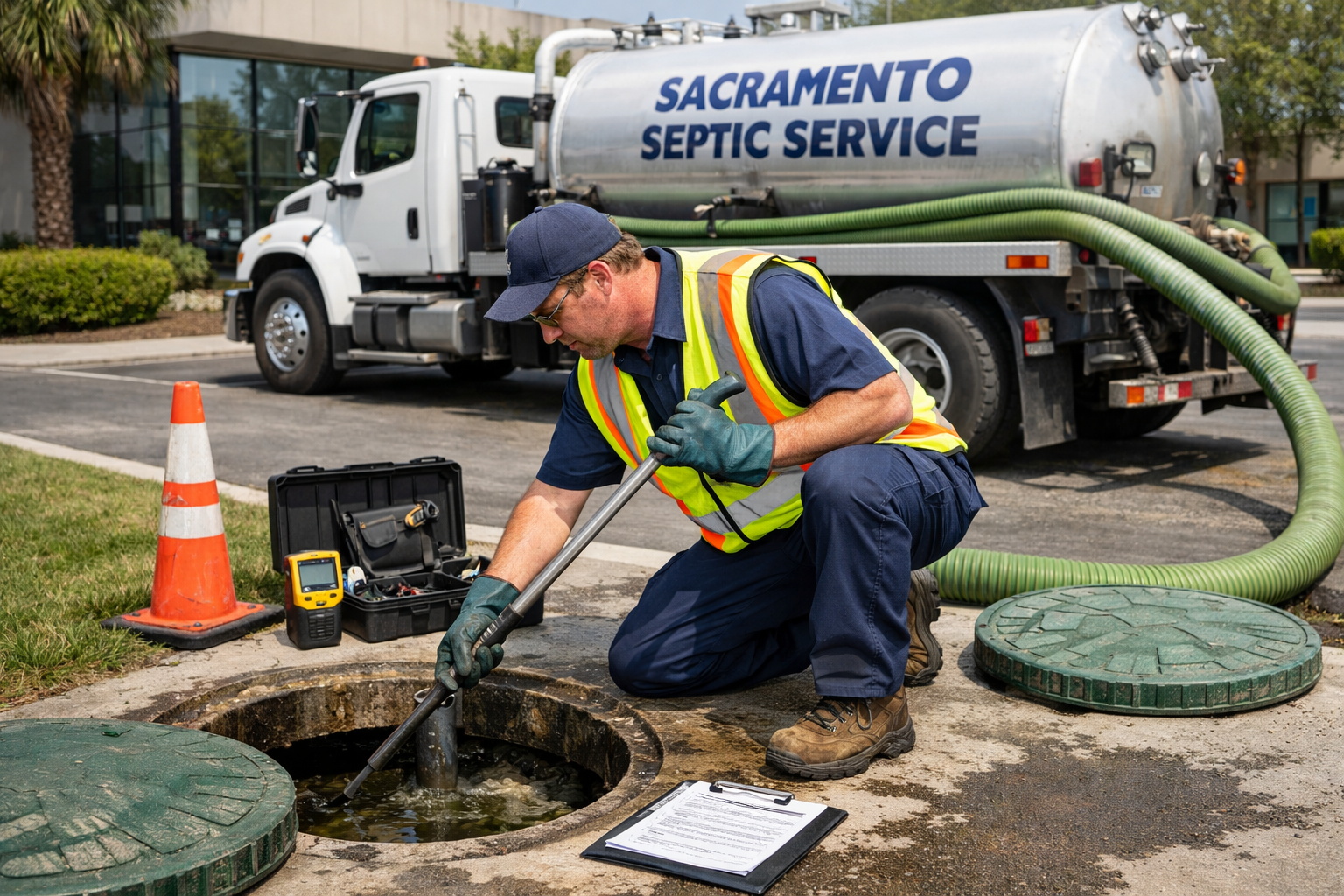The Real Reason Septic System Upkeep Prevents Costly Home Disasters
If you have ever dealt with slow drains, unpleasant odors, or a surprise septic backup, you know how disruptive septic issues can be. Many Sacramento homeowners assume their septic system runs on autopilot, but the truth is that consistent septic system upkeep is what keeps everything flowing smoothly year after year. When small maintenance tasks are overlooked, they often snowball into costly repairs, stressful emergencies, and avoidable system failures.
The good news is that keeping your system healthy does not require complicated technical know how. A few straightforward habits, combined with occasional professional services, can dramatically extend your system’s life. With the right septic maintenance routine, you can avoid expensive repairs and emergency pumping while improving household sanitation and environmental safety. In this guide, we will walk through the steps, habits, and expert backed strategies that make septic system upkeep simple, predictable, and effective for Sacramento homeowners.
Why Septic System Upkeep Matters for Sacramento Homeowners
Septic systems are built to be durable, but they are not indestructible. Without proper septic tank maintenance, waste builds up, drain fields become stressed, and the system loses efficiency. Sacramento’s soil conditions and seasonal shifts make routine septic system maintenance especially important. Information published by the Environmental Protection Agency (EPA) provides helpful insight into how proper septic care protects local water sources and environmental health.
When homeowners understand how their system works and what septic system maintenance prevents, staying consistent becomes much easier. Proper upkeep prevents expensive failures, extends the life of the drain field, reduces contamination risks, and keeps your home’s plumbing functioning smoothly. Many homeowners mistakenly assume pumping alone is enough, but effective upkeep includes several ongoing habits.
How to Perform Effective Septic System Upkeep at Home
Septic system upkeep becomes easier once you understand what supports system health and what quietly creates strain. The following steps offer practical guidance to maintain reliability and longevity.
How Septic Upkeep Functions Effectively
Understanding how a septic system functions makes septic maintenance much easier. The system relies on bacteria, tank capacity, and soil filtration to process wastewater efficiently. When harmful chemicals, non biodegradable materials, or excessive water use disrupt this balance, performance declines. Articles on The Spruce explain how each component contributes to system health. These insights help homeowners make decisions that support long term septic performance.
Why Regular Pumping Schedule Matters
Routine pumping is essential for septic tank maintenance. Pumping removes solids before they clog the drain field and cause major repairs. Most Sacramento households need pumping every 2 to 4 years depending on usage and septic tank pumping frequency. Homeowner comparison sites such as Angi provide additional clarity on typical pumping intervals. Following a consistent schedule protects your drain field and prevents blockages.
Where Common Septic Problems Start
Many septic system issues originate from daily habits: flushing wipes, using too much bleach, pouring grease down sinks, or running multiple high water appliances at once. These behaviors place strain on the system and accelerate wear. Cost guides from HomeGuide demonstrate how common mistakes quickly lead to expensive repairs, making preventative habits essential.
Step 1: Schedule Routine Septic Pumping
Pumping removes accumulated solids that would otherwise clog the drain field. Begin by checking previous service dates or contacting a professional for a recommended pumping schedule. Many Sacramento homeowners rely on professional septic tank cleaning and pumping services for this essential maintenance.
Pro Tip: Larger families or homes that use garbage disposals often require more frequent pumping.
Step 2: Reduce Excessive Water Usage
Excessive water use overwhelms the septic system and prevents solids from settling properly. Spreading out laundry loads, fixing leaks, and installing high efficiency fixtures are effective ways to stabilize usage. Homes with lift stations benefit from periodic servicing through professional lift station pumping services.
Pro Tip: Space major water-using activities at least an hour apart to prevent temporary system flooding.
Step 3: Watch What You Flush and Drain
Only biodegradable waste should enter your septic system. Flushing wipes, hygiene products, or paper towels leads to clogs. Grease and chemicals also disrupt essential bacteria. Many homeowners choose professional septic riser and lid installation services to make long term maintenance more accessible.
Pro Tip: Use kitchen sink strainers to keep food debris out of the system.
Step 4: Maintain a Healthy Drain Field
A drain field filters wastewater, so keeping it intact is crucial. Avoid driving or storing heavy items on the area, and redirect downspouts to prevent soil saturation. If you suspect structural issues or need help identifying areas, consider using professional tank locating and outlet baffle replacement services.
Pro Tip: Shallow rooted grasses are the best landscaping choice above a drain field.
Step 5: Schedule Professional Inspections
Routine inspections help identify issues early. Every 1 to 3 years, hire a professional to inspect sludge levels, filters, and drain field health. For detailed evaluations, especially during real estate transactions, homeowners rely on professional real estate septic inspections with full report documentation.
Pro Tip: Combine inspections with pumping to lower long term septic pumping cost.
Practical Ways Sacramento Homeowners Benefit from Septic Upkeep
Consistent septic system upkeep reduces emergency repairs, extends drain field lifespan, and ensures smoother day to day plumbing performance. Sacramento homeowners often benefit from ongoing maintenance education such as the professional septic tank care tips provided by Blue Ribbon Septic. These simple, proactive steps protect your home and reduce risks over time.
Common Septic Upkeep Tips and Mistakes to Avoid
Maintaining a septic system becomes easier when you understand what supports it and what harms it.
• Avoid Overusing Chemical Cleaners
Harsh cleaners destroy essential bacteria. Opt for septic safe products instead.
• Monitor for Early Warning Signs
Slow drains, odors, or soggy soil near the drain field are early indicators of trouble.
• Use Water Efficiently and Consistently
Spread major water use throughout the day to protect the system.
• Keep a Documented Maintenance Log
Tracking pumping dates and inspection results ensures you stay on schedule with your septic system maintenance checklist.
• Protect the Drain Field from Weight and Roots
Avoid placing heavy objects or deep rooted plants above the drain field.
Protect Your Home with Smart Septic Upkeep
Septic system upkeep keeps your home safe, sanitary, and running efficiently. With consistent septic maintenance, you can prevent backups, avoid costly repairs, and extend your system’s lifespan. Applying these steps regularly and working with trusted local professionals ensures long term performance and peace of mind.
Frequently Asked Questions About Septic System Upkeep
- How often should I pump my septic tank in Sacramento?
Most homes require pumping every 2 to 4 years depending on usage. Following a proper septic tank pumping frequency prevents solids from entering the drain field. - What are the signs my septic system is failing?
Slow drains, odors, gurgling pipes, or soggy ground above the drain field indicate problems that may require septic tank cleaning. - Can I use bleach or chemical cleaners with a septic system?
Light use is acceptable, but frequent use harms beneficial bacteria. Choose septic safe cleaners whenever possible. - How do I protect my drain field?
Keep vehicles, heavy structures, and deep rooted plants away from the area to avoid damaging underground components.
What should I never flush into a septic system?
Avoid flushing wipes, feminine products, paper towels, grease, or harsh chemicals, as they disrupt septic system maintenance and cause blockages.






